
You are reading the older HTML site
Positive Feedback ISSUE
july/august 2008
redpoint audio designs
Model D turntable
as reviewed by Greg Weaver
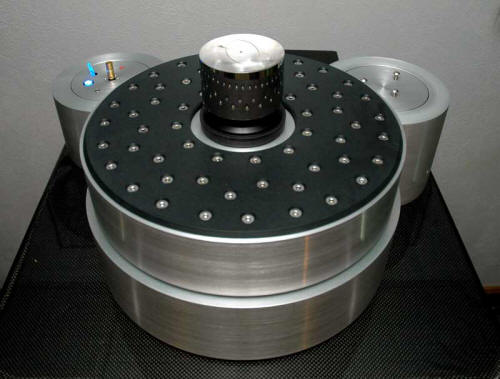
|
When I mentioned to some of my audio pals that the latest apparatus extraordinaire to arrive for audition at the audio analyst's© lair was fabricated of stainless steel, silicon, Mylar, and Teflon®™ components, included a battery power supply and weighed in at nearly 130 pounds, everyone said, "Wow, that must be some sweet new amplifier." I seriously doubt if you can begin to imagine their surprise when I replied, "Actually, no. It's the Redpoint Audio Design Model D turntable!"
Though I am not a complete stranger to suspension-less 'tables (Maplenoll, Denon, Pro-Ject, Music Hall, Simon Yorke Designs, Walker, Continuum Audio Labs, ad infinitum), I do have to admit to having been rather firmly entrenched in the suspension camp for the past several decades, as my analog system has been represented predominantly by Linn (through the '80s and early '90s), and most recently, Oracle.
My experiences with a variety of Redpoint models (at numerous shows over the last several years) has been significant, not the least of which including schlepping one, still in its shipping crates, into a room that Redpoint was sharing with Dan Meinwald during CES2005. Additionally, having had the pleasure of enjoying more than a few delightful conversations with their personable and, quite often, Fedora sporting creator, Peter Clark, I am not ashamed to admit that I was very much looking forward to spending time with this particular device.
Welcome to the Machine
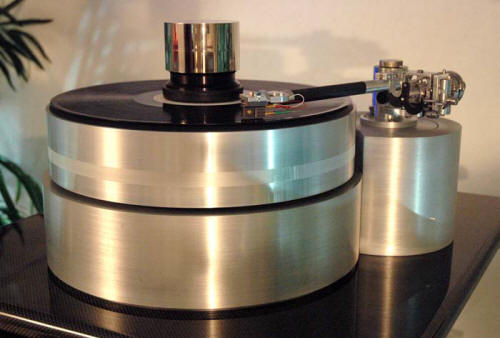
The Model D, fitted with the TriPlaner Mk. VII and Transfiguration Tempest V, residing on the composite Formula shelf atop my Grand Prix Audio Monaco Modular Isolation System.
If you are a web-head, (most readers of this on-line journal will probably qualify), you will likely recall the Teres turntable project of some years back. Peter was one of the handful of individuals associated with that well chronicled endeavor, a project that still has a considerable following. While Redpoint and Teres certainly represent the two best-known spin-off manufacturers to come out of this project, they are not alone. And although outwardly the products from those two manufactures may appear quite similar at a glance, they are markedly different. That is another story all together. There significant design difference is, however, yet another of the valid reasons I wanted to look at the Redpoint Audio Design more closely…
The model D, like all Redpoint models, consists of four basic constituent cylindrical parts; a base (it's completely inappropriate to call it a plinth), a platter, a motor pod and an arm pod. Machined to shape from a solid billet of 6061 T651 aircraft aluminum, and employing Teflon® inserts, the base of the D is twelve and three quarter inches in diameter and three and a quarter inches thick. However, mass and precise machining aren't the only things it has going for it, far from it, in fact.
The bottom of the 65-pound base of the D is machined with eighteen cavities of two differing sizes, twelve each that are an inch and a quarter in diameter and six more that are an inch and a half in diameter, all eighteen are two and a half inches deep. Each of these dozen and a half cavities is filled with a suspension of #7.5 lead skeet shot and silicone oil, and then each cavity is capped with a special aluminum plug. The novel use of differing cavity diameters filled with dissimilar materials, besides adding to the overall damping, contributes significantly to defeating resonances across a wide range of frequencies. The shot/silicone suspension formulation for the base was selected to be especially effective at damping lower frequencies.
This base houses the platter bearing, which is in itself something rather remarkable. In an attempt to achieve utter silence and perpetual motion, Peter employs a non-inverted bearing, using a Chromium Molybdenum ball riding on a Delrin® thrust plate, all housed in brass. This bearing boasts a lateral tolerance of just .0003 (three ten thousandths) of an inch! Peter is quick to point out that this is an evolving and highly custom bearing design.
Next, the 35-pound platter is twelve and a quarter inches in diameter, two and three-quarters inches thick, and mounts directly atop the base into the bearing's brass body via its integrated stainless steel spindle. The bearing fluid, a silicone oil lubricant having only the viscosity of milk, immerses the bearing. It takes more than a few seconds to settle into place after the reservoir is filled and the platter is installed. Lightly spinning the platter by hand seems to help release any air still trapped in this extremely close tolerance assembly.
After machining the platter to the proper diameter from a solid billet of aluminum, it is further machined to accept a 2" thick disc of black Teflon®. While both the older models A and B (more on that later) were fitted with an non-pigmented white Teflon®, the use of the more than twice as expensive blackened formulation was a deliberate choice for the D. The lamp-black pigment employed to blacken the Teflon® is of the same variety as that used to blacken vinyl records. At the risk of raising more than just a few eye brows, this selection was a sonic, not a cosmetic, choice. Yes, music loving audiophiles, lamp-blackened Teflon® sounds better…
This Teflon® disc is pressed into the machined cavity in the top of the platter carrier and mechanically affixed with 60 #10 x 32, two and a quarter inch long stainless socket head fasteners, each counter-sunk into the Teflon®! The bottom of the platter is machined in a similar fashion to the base, this time with two-dozen one-inch diameter by two-inch deep cavities. Since the two inch thick layer of Teflon® is countersunk into the top of the two and three quarter inch thick platter, drilling to a two inch depth from the bottom means that these cavities course through both the aluminum carrier and the Teflon® seat. Once again, each cavity is filled with a suspension of #7.5 shot and silicone oil. However, the silicone oil used in this application is of a different, slightly thinner viscosity than that used in the base. Each of the cavities is again sealed with an aluminum cap.
The 12-pound motor pod is six and three-eight inches in diameter, stands four inches high, and houses the DC motor. This motor employs precious metal brushes and sleeve bearings, and is powered by a 12 volt, 1.5 AH sealed lead-acid battery. The included battery charger plugs into a DC receptacle on the lower back of the pod. Peter says that the included charger may be left plugged into the battery with no adverse impact on either battery life or sonic performance. Here, four resonance control shot and silicone-filled cavities are employed, each an inch and a quarter in diameter by an inch and a half deep. Though the same shot is used in the suspension yet again, the silicone oil used here is of yet a third differing viscosity, even thinner than that used in the base or platter.
A brass drive sheave is mounted to the motor shaft, which protrudes through the center of the motor pod top plate. To its immediate left is a push button on-off switch and a bat handle toggle switch to select 33⅓ or 45 rpm, and both illuminate blue when in service. Recessed into the top plate just behind the spindle are two metering test points. Two corresponding adjustable potentiometers are flush mounted immediately in front of them, on the other side of the two switches. Because the speed settings are infinitely variable, once achieve the proper operating speed with, say, a speed strobe, you may record the reference voltage for each speed. Once that reference is established, you may use a voltmeter to monitor the voltage across those contacts to verify or, via the corresponding potentiometer, reset the table's speed. Nice feature, thank you.
Drive from the motor sheave to the platter is transferred by means of a Mylar drive belt around the outside of the platter. The drive belts come in a number of thicknesses and formulations, all derived from half-inch wide magnetic tape of some variety and affording varying degrees of musical subtlety—and fragility. There is a 3.5 mil thickness based on audio mastering tape, a 2.5 mil thickness based on audio leader tape (which is what I used for this evaluation), a 1.5 mil thickness based on video VHS tape, and two thicknesses based on data tape at .5 and .25 mil thick, all sans their ferrous coating.
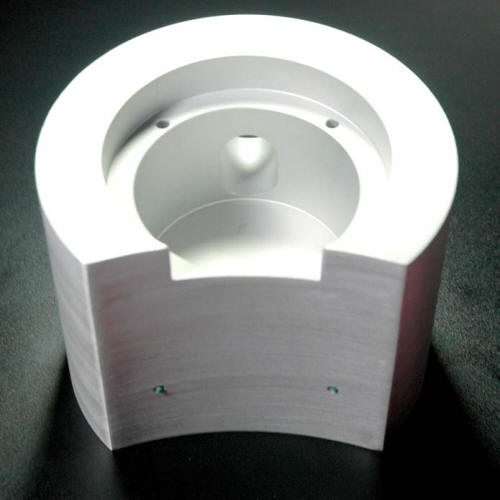
A look at the top of the Model D 9" arm pod with the arm board removed. Note the oval opening for captured tonearm cables to exit the pod.
The 14-pound arm pod cylinder is hollowed out from the top to accept differing customized top plates (i.e., arm boards). It is six and three-eight inches in diameter and stands 5 inches tall. For twelve-inch tonearms, a perfectly round cylinder is provided. For nine-inch arms, though essentially cylindrical, the pod is machined in contour, matching the outer circumference of the base, to allow it to rest up close to, though not directly against, the base. This arm pod has two rubberized setscrew spacers to prevent metal-to-metal contact should the chosen arm geometry necessitate extremely close proximity to the base.
The top plate for the nine-inch arm pod is secured to the base by four lengthy 5/32" hex head machine screws inserted from the bottom of the pod. This arm pod has a one-inch by two and a half inch opening in its back. Once an arm has been selected and mounted to the top plate, its leads (captured, single-ended, or balanced) can be fed down into the pod and out through this reasonably sized oval opening in the back. Obviously, this is not necessary with arms like the TriPlanar, which use cable sets that do not need to penetrate the arm board.
Not surprisingly, just as the previous three components, the arm pod possesses resonance control cavities. The pod I have, for nine-inch arms, has three while there are four cavities in the arm pod for twelve-inch arms. Each cavity in either of these pods is one and a quarter inch in diameter by one and a half inches deep. For the first time, this pod employs the same shot and silicone recipe as the motor pod. In these two smaller diameter pods, the formulation was optimized to better damp high frequencies.
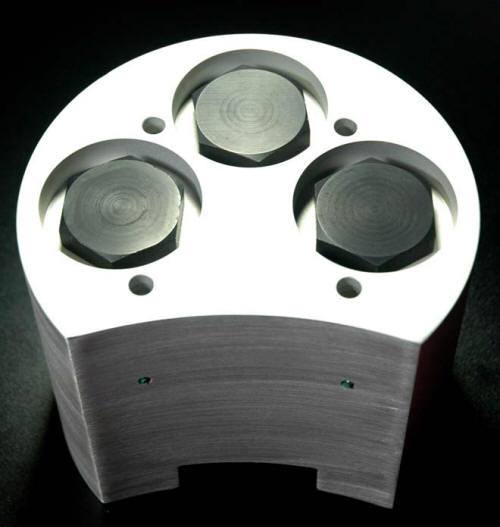
A look at the bottom of the arm pod, showing the caped off resonance control chambers.
One thing that differentiated the now discontinued Models A and B from the Model D was that both the former used a thinner (only one inch thick) disc of white Teflon®. The other big difference included the degree of damping employed. The A had the damping cavities only in the platter while on the B, both the platter and base enjoyed the dampening.
Finally, a mass (as opposed to a friction or threaded) type record clamp is included, of which there are two varieties. The T2 is a single piece of stainless, machined hollow and filled with shot and silicon (like the rest of the table components), with its weight varying between 3 and 4.5 pounds. I received the 2P (two part) clamp, which has its machined stainless top JB Welded to the HRS puck.
Once freed from its sturdy two custom fitted Pelican 1610 shipping cases and assembled atop my Grand Prix Audio Monaco, it presents a striking and commanding sight.
Parade of benefactors
For this review, I was fortunate to have the support of a number of manufacturers. Bob Graham provided a Phantom B-44 and Dung Tri Mai supplied a current model Tri-Planar Mk. VII. Bob Clarke of Profundo also graciously got involved, sending me a Transfiguration Temper V cartridge, a stirringly musical cartridge that I have subsequently purchased.
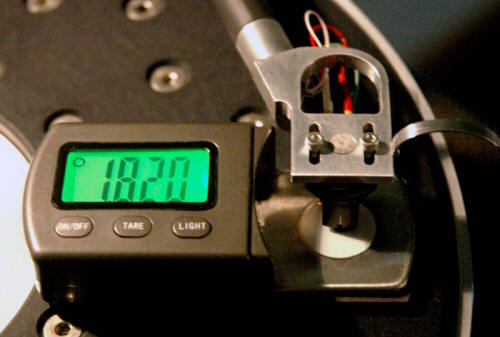
Using the AcousTech Stylus Force Gauge to dial in the Transfiguration Temper V on the TriPlaner Mk VII to exactly 1.82 grams…
Finally, a special thank you goes out to Alvin Lloyd of Grand Prix Audio who was kind enough to send me one of the large Formula shelves for my Monaco Modular Component Isolation system, a project we have been discussing for some time. Even though the three-quarters of an inch thick clear acrylic top shelf of my GPA Monaco system would have been adequate to support the weight of the Model D, it somehow seemed the appropriate opportunity to make the move to the cost-no-object, unique cellular structure and cross-linked resin system Formula shelf.
Given its remarkable effectiveness, I feel that a brief sidebar is warranted. The distinctive core material used in the GPA Formula shelf was originally developed for nuclear facilities, aerospace, and aviation isolation applications. The distinctive looking carbon fiber shell, combined with this proprietary core, exhibits a high strength to weight ratio, and provides substantial resistance to the transmission of vibration across a broad frequency range.
To stop at saying the GPA Formula shelf is effective would be like saying that the Arctic Circle gets "chilly" in winter. Replacing the clear acrylic top shelf under the Model D, the formula shelf's impact and contribution was more significant than I could have imagined, even given my previous experience with all things GPA. I was afforded even more space than previously, in all three dimensions. I was treated to more accurate sizing and more clearly defined localization of instruments. And quietness became even quieter! The overall background calm established from which the music is permitted to emanate was even darker with the formula shelf in place... I sent my check!
Livin' Seven "D" Large
While it might seem that the obvious question could be, "What sets the Redpoint Model D apart from the pack of similarly (and much higher) priced tables," The better question might be, "What doesn't!" No, reeeally. It is that good.
Depth
The first characteristic of the Model D to masterfully assert itself upon my unsuspecting psyche was its steadfast ability to courageously and completely render the lowest octave. Deep bass recreation on the D was center-of-the-earth solid, unparalleled in D-E-P-T-H, with extraordinarily accurate tone, pitch definition, and detail. In my thirty plus years in this game, I have yet to hear more accurately and powerfully recreated bass recovery from any source. Read that again, 'cause I'm not joking…
Many of my favorite bass leaden recordings began to reveal themselves to be not merely impressive, but to be truly magnificent, with all their power and detail being revealed anew by the D, especially when using the TriPlanar Mk. VII. I was suddenly hearing much more detail and, recording specific, ridiculously greater depth in bass information from recordings, some of which I've owned and listened to for decades.
Drama
Starting with a sonic spectacular that is on all the short lists, Feste Romane (Mobile Fidelity MFQR 1-507), I was dealt a musically devastating delight. The sheer splendor of the tone and primal intensity of the call of the horns in the fading passages of "Pini Di Vila Borghese" was simply unparalleled in my experience. The power and the majesty of the Cleveland Symphony Orchestra under the direction of Lorin Maazel have never been so faithfully or convincingly conveyed. As the orchestra's power swells early on in "Pini Presso Una Catacomba," supported by the irrefutable and staggering low frequency reproduction capabilities of the Model D, I was completely overwhelmed with the musical message of this Respighi tone poem. Though I've owned this record for some time, it is no cliché to say that I have never really heard its message prior to the arrival of the Redpoint Model D.
Drive
Change gears and dig into ZZ Top's, Tres Hombres, (AWAR 274492),
originally released in 1973. This recent kick-ass remaster, done by
Steve Hoffman and Kevin Gray at their
AcousTech Mastering facility in Camarillo, CA, was cut from the
original analog master tapes. When you hear this reissue, you'll
understand why this gale-force blues-rock juggernaut,
only the trio's third release, shot this little Texas band to stardom.
Starting with the visceral punch and impact of the drums that open "Waiting For The Bus," the powerful assault of John Beard's drumming is recreated with total authority and power; the D leaves no doubt that it is in complete control. Sliding right on into the creamy purity of the strummed guitar strings in "Jesus Just Left Chicago" on the same release, you can't help the feeling that the guitar actually exists in your room. Never before had this rowdy rock-fest, which always manages to get a party started, sounded so alive, so real, and so musically harmonious. And talk about pace and drive! It's there in spades, dear music lover.
Dynamics
Dynamic event reconstruction, both large and subtle, is almost effortless and with seemingly every bit as nuanced as can be captured. The stirring dynamic drum crescendos in "Under the Boardwalk," from the Rickie Lee Jones 1983 10" EP, A Girl at her Volcano have never sounded so starkly powerful and, at the same time, so completely effortless. The vocal tracks, including those of supporting vocalists Michael Ruff and Leslie Smith, are so solid, so well defined, so localized, and so liquid, that you have no trouble discerning every nuanced breath in their contributions to this killer little EP. Though this has long been a test record for me, I was shocked to witness, finally, the full transparency and fine microdynamic shading it affords, all at the pleasure of the Redpoint Model D.
Midrange is utterly alive with tonal color, transient information, and bursting with energy. By the time I pulled out the Dixie Dregs 1980 masterpiece Dregs of the Earth (Direct Disk Labs SD 16622), I knew I was going to be in for a treat. Even though this album's recording and subsequent remastering was never of a caliber that anyone would typically consider to embody audiophile excellence, its underlying musical heart make it a must have.
Delicacy
From the opening cut, "Road Expanse," this disc was portrayed with more balance and delicacy than I had ever before noted—or believed possible, given its less than textbook pedigree. Nevertheless, just throw it on the D and you are treated to the meaty, full-bodied romp of the bass guitar in "Twiggs Approved." Even the cymbals on the recording, which I had always found to be portrayed through a pasty, white-ish "haze," were allowed a degree of clarity and shimmer never before realized. Move on to "Hereafter" for a taste of what the D can serve up with even moderately well recorded music.
For the first time, with the Redpoint Model D, the brilliant light of these remarkable jazz influenced rock arrangements was allowed to show through clearer, with more detail, harmonic texture, and most notably, musical significance, than I had ever believed had been captured on this album. The level of transparency and authority the D lends to any LP lucky enough to be clamped aboard for an exquisite ride is unsurpassed in my experience, allowing for a more natural, fuller, and more enriching musical experience. The damn thing just exudes MUSIC!
Dimension
As a re-constructor of the venue and soundstage, it is unsurpassed in my experience - period. Whether recreating the Q Sound spatial cues from the likes of Roger Waters' 1992 2-album magnum opus, Amused to Death (Holland: Columbia 01-468761-20),or Pink Floyd's 1994 live 4-album set Pulse (British: EMI 7243-8-32700), or the across-the-stage span of Carey Bell, Billy Branch, James Cotton, ang Junior Wells on "Down Home Blues," the opening cut on Harp Attack (Alligator LCD4790), the solidity of the space and the specificity of instrumental voices is textbook. No easy accomplishment, yet the D interprets them all with apparent effortlessness.
The term silent doesn't begin to describe the complete and utter calm the D so effortlessly and consistently portrays—unless the recording is fraught with noise. The silence between passages on my ultra disks (MoFi UHQR's for example) was almost undetectable from my listening chair. This table is UTTERLY confidant in its reconstruction of the musical event. While I have heard a similar degree of confidence from other tables, none in my experience surpass it.
Detail
Overall, treble is at once highly detailed and vibrant, articulate and full of shimmer and life! It offers as full and realistic tonal color and texture as I've heard from any of the "Big Boys," with lifelike bloom, air, and focus. Nothing in my library tripped it up or caused it ANY rhythmic misstep or dynamic blunder. Imaging is laser-focused, and the soundstage is robust and—bigger; not blown-out-of-proportion bigger, but more realistic in width, height and depth bigger, recording permitted.
Not to put too fine a point on the matter, but the Redpoint Model D is the finest sounding, most exciting turntable to every cross my threshold. Further, it is undeniably one of the 4 or 5 finest sounding 'tables I've ever experienced—regardless of asking price—period.
Aren't there ANY shortcomings?
On the downside, there are only two points I can even begin to defend. First, some users will undoubtedly find fussing with the belt tension as curious and difficult. I found the tensioning method remarkably intuitive; too tight and the motor spindle won't start, too loose and the platter won't start. See? Simple.
Yet, I'm sure that because of the trial and error necessary to "nudge" the rather heavy motor pod into just the right position, some may find that process to be less convenient than many more common belt systems. The only other negative to mention is the lack of a dust cover. Given the table's unique design, achieving this superficial goal would be a significant chore and would likely spoil both the performance and aesthetic of this otherwise superb device.
Dancing with Mr. D…
Were you wondering about the name, Redpoint? With just a bit of poking around, I discovered the name was derived from a rock climbing term.
Redpoint (noun): In rock climbing, a successful ascent of an extremely difficult route - requiring dedicated perseverance in order to achieve success.
Given what I have heard from the Model D, that name makes considerable sense. Let me explain.
The arrival of the nearly 130 pound, $24,900 Redpoint Audio Design Model D has been revelatory, to say the least. While you can't exactly call the Model D "affordable," when you consider the sheer number of 'tables available today that exceed $50,000, even $70,000, you'd be hard pressed to call it extravagant. And while the bulk of today's mega-buck tables are significantly more complex, employing elaborately sophisticated, often intricate approaches to decoding vinyl, the Model D is downright elegant in its simplicity.
And once you are treated to its exquisite, world-class performance, easily on par with any table I've heard at 2, or even 3, times its price, I'm compelled to suggest that, all else being equal (i.e., its resultant stunning sonic performance), this degree of achievement, when viewed in the light of its elegantly simplistic engineering approach, would almost demand that it be seen as the better approach. Point, set, and match, Redpoint.
What an accomplishment! The D provides bone-crushing bass, living, breathing midrange and treble so crisp and clear you'll recognize a cymbal's brand. If the Redpoint Audio Design Model D isn't unquestionably the lead dog running with the analog pack, it certainly isn't far enough back to be spattered by any mud thrown up by the few paws that may run slightly ahead of it... Though it required some serious effort on my part, I have come to terms with Peter and will be keeping this glorious music making device. Go out of your way as far as necessary, painfully so if need be, to have the Redpoint experience. You will NOT soon forget the encounter. Most MUSICALLY recommended. Greg Weaver
Redpoint Audio Design LLC
4841 North Scottsdale Road Suite 102
Scottsdale, Arizona 8525
email address: [email protected]
web address:
www.redpoint-audio-design.com
